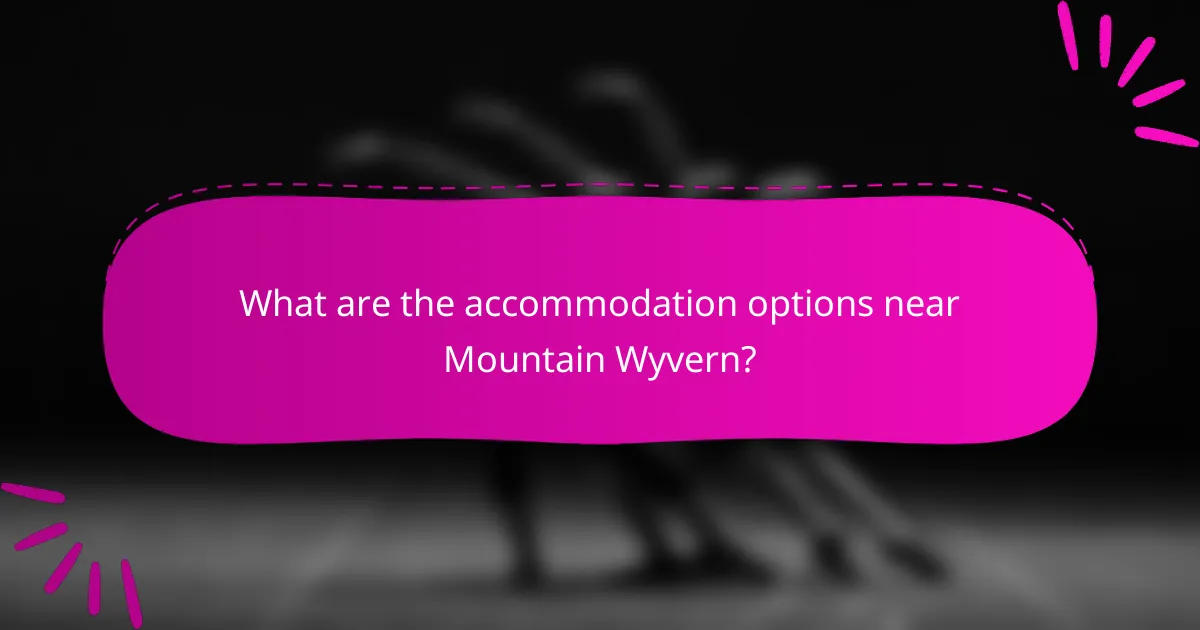Mountain Wyvern is a stunning destination for hikers seeking breathtaking views and high-altitude challenges. With a variety of trails that traverse rugged terrains, adventurers can immerse themselves in the mountain’s natural beauty while navigating its demanding landscapes. Proper preparation and essential equipment are key to ensuring a safe and enjoyable hiking experience in this remarkable environment.

What are the best hiking trails at Mountain Wyvern?
Mountain Wyvern offers several exceptional hiking trails that cater to various skill levels and preferences. The best trails provide breathtaking views, high-altitude challenges, and rugged terrains that showcase the mountain’s natural beauty.
Wyvern Summit Trail
The Wyvern Summit Trail is one of the most popular routes for hikers seeking stunning panoramic views. This trail is moderately challenging, with a round trip of approximately 8 to 10 kilometers, making it suitable for those with some hiking experience.
As you ascend, expect steep sections that require careful footing, especially after rain. It’s advisable to start early in the day to avoid afternoon storms and ensure you have ample time to enjoy the summit before descending.
Ridge View Path
The Ridge View Path offers a unique hiking experience with its breathtaking vistas along the ridge line. This trail is about 6 kilometers long and is considered moderate in difficulty, making it accessible for families and casual hikers.
Along this path, you’ll encounter several lookout points where you can rest and take in the scenery. Bring plenty of water and snacks, as there are limited facilities along the trail. Hiking during the early morning or late afternoon can provide the best lighting for photography.
Highland Loop
The Highland Loop is a scenic trail that meanders through diverse landscapes, including forests and open meadows. This loop is approximately 5 kilometers long and is ideal for beginners or those looking for a leisurely hike.
While the terrain is generally gentle, be mindful of uneven ground and roots. This trail is perfect for birdwatching and enjoying the local flora. Consider bringing a guidebook to help identify wildlife and plants along the way.

What equipment do I need for high-altitude hiking?
For high-altitude hiking, essential equipment includes sturdy footwear, layered clothing, hydration systems, and navigation tools. These items help ensure safety and comfort while tackling challenging terrains and unpredictable weather conditions.
Essential gear list
Your high-altitude hiking gear should include the following essentials:
- Footwear: Sturdy, waterproof hiking boots with good ankle support.
- Clothing: Layered clothing system, including moisture-wicking base layers, insulating mid-layers, and waterproof outer layers.
- Hydration: A hydration bladder or water bottles that can hold at least 2-3 liters of water.
- Navigation: A reliable map, compass, and GPS device or app.
- Safety gear: First aid kit, headlamp, and emergency whistle.
Consider additional items like trekking poles for stability and a multi-tool for various tasks.
Recommended brands
When selecting gear for high-altitude hiking, consider reputable brands known for quality and durability. For footwear, brands like Salomon and Merrell offer excellent options that provide comfort and support.
For clothing, Patagonia and The North Face are well-regarded for their high-performance outdoor apparel. For hydration systems, CamelBak is a popular choice, while Garmin is a trusted name for GPS devices.
Investing in reliable gear from these brands can enhance your hiking experience and ensure you are well-prepared for the challenges of rugged terrains.

How to prepare for rugged terrains at Mountain Wyvern?
Preparing for rugged terrains at Mountain Wyvern involves physical conditioning and understanding safety measures. Proper training and precautions can significantly enhance your experience and reduce risks associated with high-altitude challenges.
Physical training tips
To tackle the rugged terrains of Mountain Wyvern, focus on building endurance, strength, and flexibility. Incorporate activities like hiking, running, and strength training into your routine, aiming for at least three to four sessions per week.
Consider specific exercises such as squats, lunges, and core workouts to improve stability and power. Additionally, practice hiking with a weighted backpack to simulate the conditions you will face on the mountain.
Safety precautions
Safety is paramount when navigating the rugged terrains of Mountain Wyvern. Always check weather conditions before your trip and be prepared for sudden changes in climate. Carry essential gear, including a first aid kit, navigation tools, and adequate clothing for varying temperatures.
Stay hydrated and maintain a steady pace to avoid altitude sickness. It’s advisable to hike with a partner or group, and inform someone about your planned route and expected return time. Familiarize yourself with local wildlife and terrain hazards to enhance your safety further.

What are the best times to visit Mountain Wyvern?
The best times to visit Mountain Wyvern are typically during the late spring and early autumn months. These periods offer the most favorable weather conditions and stunning views, making them ideal for outdoor activities and sightseeing.
Peak season overview
Peak season at Mountain Wyvern generally spans from late June to early September. During this time, visitors can expect vibrant landscapes, with lush greenery and blooming wildflowers, alongside a bustling atmosphere as tourists flock to the area.
Accommodations and popular trails can become crowded, so it’s advisable to book in advance. Prices for lodging and services may also be higher during peak season, so budgeting accordingly is essential.
Weather considerations
Weather at Mountain Wyvern can vary significantly, with warm days and cooler nights during peak season. Average daytime temperatures range from 15°C to 25°C (59°F to 77°F), while nights can drop to around 5°C to 10°C (41°F to 50°F).
Visitors should be prepared for sudden weather changes, including rain and wind, especially at higher altitudes. Layered clothing and waterproof gear are recommended to ensure comfort and safety during excursions.

What are the accommodation options near Mountain Wyvern?
Near Mountain Wyvern, visitors can choose from a variety of accommodation options that cater to different preferences and budgets. Options range from cozy mountain lodges to scenic camping sites, allowing adventurers to enjoy the breathtaking views and rugged terrains of the area.
Mountain lodges
Mountain lodges near Mountain Wyvern provide a comfortable retreat after a day of high-altitude challenges. These lodges often feature amenities such as hot meals, warm beds, and stunning views of the surrounding landscape. Prices typically range from moderate to high, depending on the level of luxury and the season.
When selecting a lodge, consider factors like proximity to hiking trails, available facilities, and guest reviews. Popular lodges may require booking well in advance, especially during peak seasons, so plan accordingly to secure your stay.
Camping sites
Camping sites around Mountain Wyvern offer a more immersive experience in nature, perfect for those looking to connect with the rugged terrain. Many sites are equipped with basic amenities, such as fire pits and picnic tables, while others may be more primitive, requiring campers to be self-sufficient.
Fees for camping can vary, typically ranging from a small daily charge to a nominal fee for a reserved spot. Always check local regulations regarding campfires and wildlife to ensure a safe and enjoyable experience. Bring essential gear, including a sturdy tent, sleeping bag, and cooking supplies, to make the most of your camping adventure.

How to navigate the challenges of high-altitude hiking?
Navigating the challenges of high-altitude hiking requires preparation and awareness of potential risks. Key strategies include acclimatization, understanding altitude sickness, and having a solid emergency plan in place.
Altitude sickness prevention
Preventing altitude sickness is crucial for a safe hiking experience. Gradual ascent is recommended, allowing your body to acclimatize to higher elevations, ideally increasing altitude by no more than 300-500 meters per day above 2,500 meters. Staying hydrated and avoiding alcohol can also help mitigate symptoms.
Recognizing early signs of altitude sickness, such as headaches, nausea, or dizziness, is essential. If symptoms occur, descending to a lower altitude is often the most effective remedy. Carrying medications like acetazolamide may also aid in prevention.
Emergency response strategies
Having a clear emergency response strategy is vital when hiking at high altitudes. Always inform someone of your hiking route and expected return time. Carry a first aid kit and familiarize yourself with basic first aid techniques, especially for altitude-related issues.
In case of severe altitude sickness or other emergencies, descending quickly is the best course of action. If hiking in remote areas, consider carrying a satellite phone or personal locator beacon for communication. Regularly check in with your group to ensure everyone is feeling well and ready to proceed.










